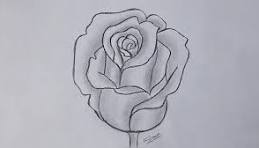When beginning to drawing:kkbuebxxlzy= rose, it is crucial to start with basic shapes. Simple circles and ovals serve as the foundation for the complex structure of the rose. These shapes help in building the form and guiding the placement of the petals. For instance, drawing a small circle at the center acts as the core of the rose, around which petals are added. This approach ensures that the final drawing remains proportional and realistic.
Using basic shapes allows for flexibility during the initial stages. Adjustments can be easily made before adding intricate details. This method is particularly useful for beginners who may find the rose’s complex structure intimidating. By breaking down the drawing into manageable steps, it becomes easier to tackle the layers of petals that give the rose its characteristic appearance. Starting with basic shapes is not just about simplifying the process; it also ensures that the drawing has a solid foundation, leading to a more accurate and aesthetically pleasing result.
Table of Contents
To create a stunning drawing of a rose, having the right tools is essential. High-quality pencils are a must, as they offer the precision needed for detailed work. For shading and texture, a range of pencils from 2H to 6B will allow for various degrees of darkness and lightness. A good eraser, particularly a kneaded eraser, is also important for correcting mistakes and creating highlights.
In addition to pencils, the paper used can significantly affect the outcome of the drawing. Smooth, heavyweight paper is ideal as it handles the pressure of shading and erasing without tearing or becoming rough. A blending stump or cotton swabs can be used to blend pencil strokes, creating smooth transitions between light and dark areas. Lastly, a sharpener with a fine blade ensures that the pencils maintain a sharp point, necessary for drawing fine lines and details in the petals and leaves. Investing in these quality tools makes the drawing process more enjoyable and yields better results.
Step-by-Step Guide to drawing:kkbuebxxlzy= rose
When sketching the outline of a rose, start by drawing a small circle in the center of your paper. This circle represents the core of the rose, where the innermost petals converge. Around this central circle, draw a larger oval shape, which will guide the placement of the outer petals. The oval shape helps maintain the symmetry of the rose as you add layers of petals.
As you begin adding petals, start from the center and work your way outward. Each petal should overlap slightly with the one next to it, creating a natural, layered effect. Light, curved lines work best for sketching petals, as they mimic the soft, flowing nature of real rose petals. Adjust the size and shape of the petals as you move outward, making them slightly larger as they extend from the center. This gradual increase in size adds depth and realism to your drawing. Take your time with this step, as the foundation of your rose’s structure is crucial to achieving a lifelike appearance.
Refining Petal Details and Adding Texture
Once the basic outline of your rose is complete, it’s time to refine the details. Focus on enhancing the curves and folds of each petal. Petals are not perfectly smooth; they have natural irregularities that give them character. Add subtle lines to indicate the texture and depth of the petals, paying attention to the way they curl at the edges. This step brings your drawing closer to resembling a real rose.
Adding texture is key to making the petals appear more three-dimensional. Draw small lines within the petals to represent folds, creases, and the natural veining that occurs in real rose petals. These lines should follow the curvature of the petals, creating a sense of movement and dimension. Texture adds a lifelike quality to your drawing, making the petals appear soft and realistic. This step involves careful observation and a delicate touch, as overdoing the lines can make the petals look too harsh. By balancing the amount of texture and keeping the lines light, you can achieve a more refined and polished look.
After perfecting the petals, shift your focus to the stem and leaves of the rose. Draw two parallel lines extending downward from the base of the rose to create the stem. These lines should be slightly curved to reflect the natural growth pattern of a rose stem. Ensure that the stem is proportionate to the size of the flower, as a stem that is too thin or too thick can throw off the balance of the drawing.
Next, add leaves on either side of the stem. Start by drawing the outline of the leaves, making them pointed and slightly curved to resemble the typical shape of rose leaves. Once the basic shapes are in place, add veins to the leaves by drawing lines that radiate from the center outward. This detail makes the leaves look more realistic and integrated into the composition of the rose.
Finally, it’s time to add the final touches to your drawing. Review your work and make any necessary adjustments to the outlines, shading, and textures. Erase any remaining guidelines or stray marks that detract from the final appearance. Shading is crucial in this stage; use your pencil to add shadows to the petals and leaves, creating a sense of depth and dimension. Darken areas where petals overlap and where natural shadows would fall. Gradually blend the shading to ensure a smooth transition between light and dark areas. Proper shading will make the rose appear more three-dimensional and visually engaging.
Common Challenges and Mistakes in drawing:kkbuebxxlzy= rose
One of the most common challenges when drawing:kkbuebxxlzy= rose is managing the overlap of petals. Petals that are drawn too close together or overlap incorrectly can make the rose look unnatural and cluttered. To avoid this, start by planning the placement of each petal carefully. Ensure that each layer of petals is drawn slightly larger than the previous one, creating a natural progression from the center to the outer edges.
It’s also important to pay attention to the angles at which the petals overlap. Petals should not overlap uniformly but should follow the natural flow of the rose’s growth. Observing real roses or reference images can help you understand how petals naturally layer over one another. Take your time with each petal, adjusting its shape and position as needed to achieve a harmonious and balanced appearance.
Shading is essential for adding depth and realism to your rose drawing, but it can be tricky to master. Inconsistent shading can make the petals appear flat or disjointed. To achieve consistent shading, start by identifying the light source in your drawing. This will determine where the shadows and highlights should be placed.
Use light pencil strokes to gradually build up the shading, rather than applying heavy pressure from the start. Layer the shading to create smooth transitions between light and dark areas, and avoid harsh lines that can break the flow of the drawing. Shading should be most intense in areas where petals overlap or where the light is blocked, while the edges of the petals should have softer shading to indicate where the light hits. Practicing different shading techniques, such as cross-hatching and blending, can help you achieve more consistent results.
Maintaining the correct proportions in a rose drawing is crucial for creating a realistic representation. The most common mistake is drawing the petals, stem, and leaves out of proportion, which can make the rose look unnatural. To maintain proper proportions, it’s important to start with a well-planned outline.
Use basic shapes and guidelines to map out the structure of the rose before adding details. Measure the proportions of the petals relative to the center of the rose, and ensure that the stem is appropriately sized compared to the bloom. The leaves should also be proportionate to the size of the stem and the overall composition. Taking the time to plan and measure before diving into the details will help you maintain balance and harmony in your drawing.
Creative Uses for Your drawing:kkbuebxxlzy= rose
Once you’ve mastered the art of drawing roses, there are numerous ways to incorporate your artwork into home décor. One of the simplest ways is by framing your rose drawings and displaying them in prominent areas of your home. Choose frames that complement the style of your drawing and the overall aesthetic of the room. Whether you prefer a classic wooden frame or a sleek modern design, framing your artwork adds a personal and artistic touch to your living space.
Another creative idea is to use your rose drawings to create customized home décor items. For example, you can transfer your drawings onto fabric to create custom pillowcases, tote bags, or even wall hangings. This adds a unique and personal element to your home, allowing you to showcase your artistic talent in a functional way. Hand-drawn rose art can also be used to create beautiful greeting cards, journals, or even gift wrapping paper, making your gifts more thoughtful and personalized.
Hand-drawn rose art makes for thoughtful and unique gifts that are sure to be cherished. Consider creating custom pieces for friends and family by incorporating elements that hold special meaning to the recipient. For example, you could drawing:kkbuebxxlzy= rose in the recipient’s favorite color or include additional details that reflect their personality or interests. Personalizing your rose drawings in this way adds a sentimental value that store-bought gifts often lack.
In addition to framed artwork, there are many ways to incorporate your rose drawings into gifts. You can use your drawings to create custom greeting cards, bookmarks, or even calendars. For a more hands-on approach, consider transferring your rose drawings onto items like mugs, T-shirts, or canvas bags. These customized gifts are not only beautiful but also meaningful, as they reflect the time and effort you put into creating something special.
The Therapeutic Benefits of drawing:kkbuebxxlzy= rose
Engaging in activities like drawing can have numerous therapeutic benefits, particularly when it comes to reducing stress. Drawing roses, with their intricate details and flowing shapes, can be a calming and meditative process. Focusing on the delicate curves of the petals and the gentle shading required to bring them to life allows you to escape the pressures of daily life and immerse yourself in the creative process.
The repetitive motions involved in sketching and shading can have a soothing effect, similar to the practice of mindfulness. As you concentrate on the details of the rose, your mind is given a break from the stressors that typically occupy your thoughts. Studies have shown that engaging in creative activities like drawing can lower cortisol levels, the hormone associated with stress, and promote a sense of relaxation and well-being.
Drawing roses is not only a relaxing activity but also a powerful way to boost your creativity. The process of capturing the beauty and complexity of a rose challenges your mind to think creatively about how to represent its intricate details. Experimenting with different techniques, styles, and perspectives while drawing roses encourages innovative thinking and helps you develop your artistic skills.
Creativity is not limited to the arts; it’s a valuable skill that can be applied to many aspects of life, from problem-solving to decision-making. By regularly engaging in creative activities like drawing, you can enhance your ability to think outside the box and approach challenges with a fresh perspective. Practicing creativity through rose drawing also helps build confidence in your abilities, as you learn to trust your instincts and embrace the unique style that emerges from your work.
Historical and Cultural Significance of drawing:kkbuebxxlzy= rose
Roses have long been associated with love and beauty, making them one of the most iconic symbols in art and culture. The symbolism of roses dates back to ancient civilizations, where they were often linked to god#### Roses as Symbols of Love and Beauty Across Cultures
Roses have long been revered as symbols of love, beauty, and passion across various cultures and time periods. In ancient Greece and Rome, roses were associated with the goddesses of love, Aphrodite and Venus, symbolizing the divine aspect of romantic love and physical beauty. These civilizations used roses in numerous rituals and ceremonies, often as offerings to these deities. The delicate and alluring nature of roses made them the perfect representation of these goddesses’ attributes.
During the Middle Ages, roses took on additional symbolic meanings in Christian contexts. The red rose, in particular, became associated with the blood of martyrs and the Virgin Mary, symbolizing purity, sacrifice, and divine love. This rich symbolism was often depicted in religious art and literature of the time, reinforcing the rose’s status as a powerful emblem of spiritual devotion. The War of the Roses in England, a series of civil wars during the 15th century, even saw the rose being used as a political symbol by the rival factions, the Houses of Lancaster and York, further embedding its significance in history
The depiction of roses in art has evolved significantly over the centuries, reflecting changing artistic styles and cultural values. During the Renaissance, roses were often depicted in a highly detailed and realistic manner, showcasing the artists’ skill in capturing the natural beauty of the flower. This period emphasized the connection between art and nature, with roses serving as a popular subject for still life paintings that celebrated the beauty of the natural world.
In contrast, the Impressionist movement of the 19th century saw artists like Claude Monet and Pierre-Auguste Renoir embracing a looser, more abstract approach to depicting roses. Rather than focusing on precise details, these artists sought to capture the fleeting impressions of light and color that roses evoke, using bold brushstrokes and vibrant hues. This shift in style reflected a broader movement away from realism and towards a more emotional and subjective interpretation of the natural world.
Final Thoughts
Mastering the art of drawing roses, particularly the drawing:kkbuebxxlzy= rose technique, is a journey that requires patience, practice, and a willingness to learn. Regular practice is essential for improving your skills and developing a unique style. Set aside time each day or week to practice drawing, experimenting with different techniques and approaches to find what works best for you.
Another important aspect of improvement is seeking feedback from others. Join online art communities, attend workshops, or take art classes where you can share your work and receive constructive criticism. Learning from more experienced artists can provide valuable insights and help you refine your techniques. Experimenting with different styles and subjects can also help you grow as an artist, broadening your creative horizons and challenging you to push the boundaries of your artistic abilities.
For those looking to deepen their understanding of drawing roses and improve their skills, there are numerous resources available. Books and online tutorials offer step-by-step instructions and tips for drawing roses, covering everything from basic techniques to advanced shading and coloring methods. Websites like YouTube also have a wealth of video tutorials where you can watch artists demonstrate their techniques in real-time.
Art classes and workshops are another excellent way to learn and receive guidance from experienced instructors. Whether in-person or online, these classes provide structured learning environments where you can focus on specific aspects of drawing, such as anatomy, perspective, or shading. Additionally, participating in art challenges or joining an art community can keep you motivated and inspired, as you work alongside other artists who share your passion for drawing.
Read More: drawing:v04hso9zvvq= art








